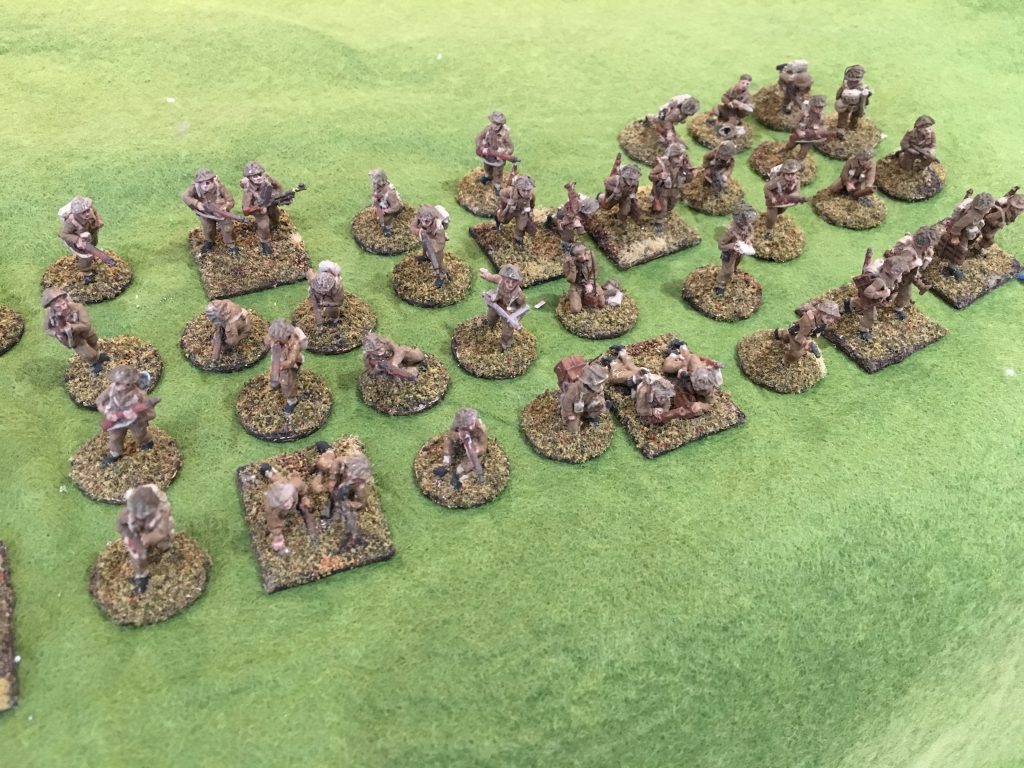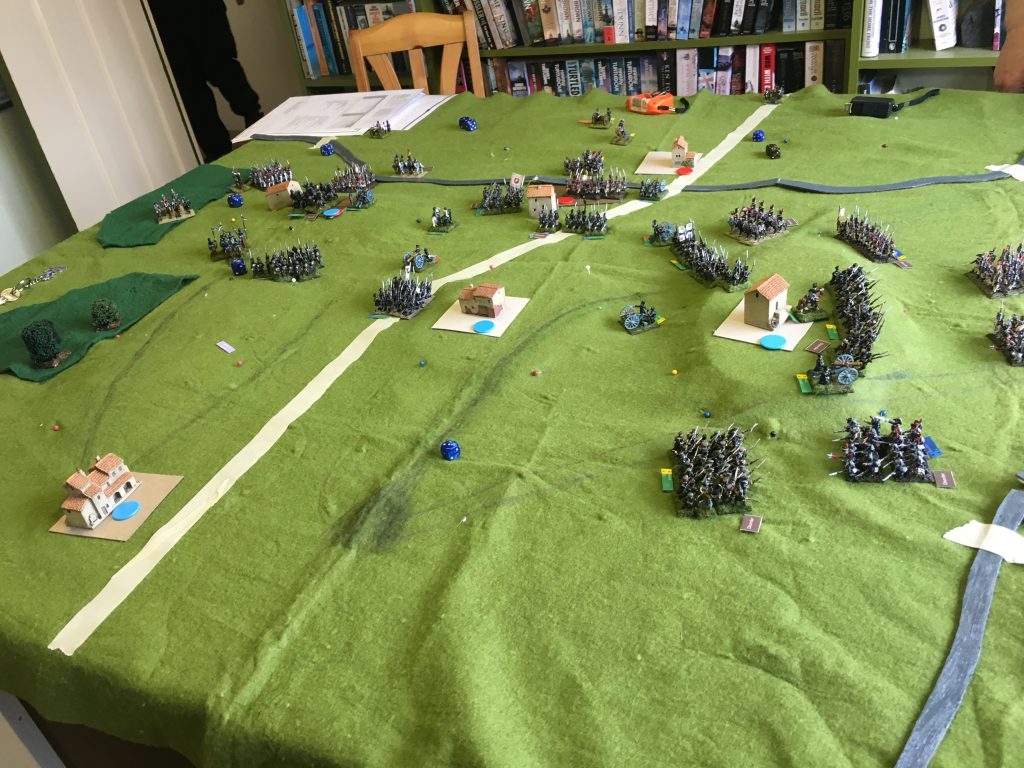After playing two games with very limited house rule adaptations (after my first with a more ambitious version that I didn’t think worked), I have plucked up courage to produce something more ambitious. After a limited play test I think they work well enough to publish here. I won’t be using them at the club for another couple of months, as I will be travelling, but while production is fresh in mind, I though I’d post something here. In my test I thought they worked surprisingly well. You can download from the Rules page.
First of all: scaling. For the standard scale of 1,000 infantry to a base, cavalry is now 333 to a base (from 1,000) or 12 guns (from 24). For the higher scale (1,500 infantry to a base) that gives 500 cavalry and 18 guns. For 1815 French and Prussians I find that an in between scale works well: 1,250/416/15. I am tempted to take the artillery scale down further, but that’s enough for now. Why? Cavalry takes up a lot more space than infantry (indeed I can only squeeze two cavalry miniatures on to the 25mm square bases, in place of six infantrymen). In the von Reisswitz Kriegsspiel (of 1824), an infantry battalion of 900 men takes up the same frontage as 375 cavalry or 10 artillery pieces. The lower scale gives much more scope to represent the variety of cavalry types, and stops them looking rather pathetically few. The British Union Brigade at Waterloo can now be its own unit of 4 bases, rather than being lumped into with the Household cavalry as a 3 base unit. And with French cavalry divisions having strength of 1,500 to 2,000, these are at the margin as two base units. Likewise artillery took up a lot space, and under BBB it is possible to create unrealistic concentrations of strength with devastating results. It also allows us to represent the different sorts of artillery (horse artillery, heavy guns and howitzers) more easily.
The next problem is that game progress is slow, because base removal only happens in quite extreme circumstances. The most common close combat result is for one side to fall back 3in with neither side taking a loss. This means that battles seem to be much slower than the time rate of one hour per pair of moves suggests. In fact Napoleonic divisions had a habit of disappearing after two or three hours of heavy combat. this wasn’t particularly from casualties, but sheer exhaustion. Muzzle loading black powder weapons made a big noise and packed a nasty recoil, and barrels got hot and clogged. Horses weren’t great on stamina either. If you look at the later stages of Ligny, after about three or four hours of fighting, neither side had many effective fighting units left. The same thing can be said for Waterloo. Under current BBB rules it isn’t hard for Lobau’s outnumbered corps to hold off Bulow’s Prussians for hours; historically they made a rapid retreat after about one hour.
The way I have tackled this is in the close combat table for infantry, where for marginal victories in either direction both sides lose a base. To balance this slightly, for a draw (where under the rules both sides lose a base, and go on to fight another round), neither side loses a base (the attacker falls back). Since infantry units are typically four or six bases, it means that the units will start to disappear rather quickly in heavy fighting. And because both sides lose a base, some of the capriciousness of base losses is removed. This is exactly how combat tended to work: both sides tended to get worn down quickly. Cavalry v. cavalry combats use the old table, as I thought this worked better. Cavalry battles had a tendency to go on for quite a time. Usually one side or other was playing for time, and it was quite easy for skilled commanders to slow things down by holding back reserves and such. Casualties were few. This is something wargames rules tend to miss.
The next point to tackle is cavalry attacking infantry. This should have an asymmetric feel that the BBB system mostly misses. When things went well, cavalry could be absolutely devastating (look at the charge of the Union Brigade, or Kellerman at Marengo). But when infantry was prepared it was often ineffective. To tackle this I have done two things. First is a new combat table for Cavalry attacking infantry, in which the asymmetry is reflected. Like the new infantry table, it is quite bloody. Attacks on infantry did wear down cavalry more than attacks on cavalry. And although infantry casualties tended to be low if discipline was maintained, muskets were still discharged and the stress doubtless took its toll. Still infantry won’t lose any bases if it wins or draws. But if it loses on a -7 result, the unit is gone. Also the infantry doesn’t fall back if it isn’t destroyed.
The second thing was to introduce the square. This doesn’t necessarily mean that the whole unit is in squares – it is more a state of readiness for cavalry attack. Squares move more slowly, are more vulnerable to fire, cannot skirmish and fire less effectively – but they offer better protection against cavalry.This has the advantage of fitting with players’ expectations, and making the game feel more Napoleonic. Also cavalry get an extra bonus if they are attacking disrupted troops – but they can’t attack infantry in difficult terrain.
The next thing is skirmishers. I hesitated on this – as my preferred approach requires some rather intricate rules. Units with skirmish capability have two or three skirmish bases (the same frontage as a normal base, but shallower and with two figures, not six). To use their special capabilities they have to be deployed in front of the unit. Small arms fire is limited to 3in (not the 6in of our previous rules). Skirmishers thus extend the range of fire for infantry, and shield the parent unit. If skirmishers take what would normally be a Disrupted result, there is no disruption but one skirmish base is lost. This means that skirmish attacks will burn out, and take a toll on the resilience of the whole unit. Finally, skirmishers can’t be used against cavalry.
And then artillery. The fire factors had to be taken down to reflect the smaller unit size; also there are slightly different capabilities between Horse, Field and Reserve (i.e.heavy) artillery, and the option of using concentrated howitzers (that’s an indulgence, as I like having howitzer models on the table). Horse artillery gets a movement bonus, so that it can move at cavalry speed if limbered, or move 6in, unlimber and fire at half effect, for example. More radically the “reduced” and “silenced” status is done away with, in about the only place where the rules are simpler than the original. In place of the former they are simply removed (they are smaller units, remember), and in the latter case they are Disrupted. My fellow gamers never liked the “silenced” rule with batteries limbering up and moving off, and it always felt a bit odd to me. The rule must have been there for a reason originally though, so we’ll see if it really works! Another radical departure is that artillery has no close combat capability. If it can’t stop attacker through fire, it is overrun. Also on artillery there are special rules for artillery attaching to an infantry unit and being treated as a joint unit for target and close combat – which reduces vulnerability to attack.
There are quite a few changes, though I have confined them to four pages of text (just).In the play test I thought they worked quite well. As expected, things moved quickly. The French tried a combined infantry and cavalry attack on the Prussians, with two infantry units and one cavalry; the Prussians had one of each (though the infantry had 6 bases to the French 4). At first it went well for the Prussians; its infantry got the better of the French, reducing both units to two bases. But in the process it became disrupted and low on ammo; it hadn’t formed square and the cavalry hit it in the flank. And it threw badly. It was wiped out. In exploitation the cavalry caught a battery in the flank and overran it. The Prussian cavalry then tried to counterattack, but it was held to a draw (both lost a base) and in the second round suffered a -4 and was wiped out. In the next French turn the cavalry then picked off another battery, annihilating the Prussians on that flank. On the other flank, the Prussians attacked but, didn’t press (confining itself to skirmishing), with French cavalry lurking on the flank. One of the infantry units tried to come to its colleague’s aid on the other flank, but too late.
This decisive result owed quite a bit to some good dice by the French at the vital moment. But it proved most unwise for the Prussians to press ahead with un-neutralised cavalry to the flank; it felt not unlike Marengo, though following up to disperse the nemy cavalry was a bonus. I thought the skirmish rules played well too, placing some interesting choices on the player. With players thinking about vulnerability to cavalry, and whether or not to skirmish, the whole game felt much more Napoleonic. It also played briskly. My main doubt now is whether cavalry becomes too dominant.
But so far, so good. Until now I have never really thought that an adapted BBB might do in place of my home grown ones. I’m a bit less sure now!

